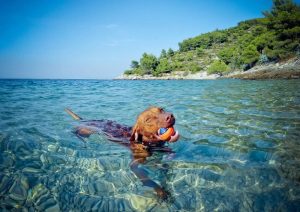Dog Swimming – With summer coming up, many dog parents are looking forward to going to the beach or the lake with their pups. However, you can’t just throw your dog Swimming in a pond and hope for the best. It takes prep work to get your dog ready to play in the water safely. Here are eight things you need to do before you take your dog on their next swimming excursion:
Table of Contents
Here are eight things you need to do before you take your dog swimming:
1. Know their overall health conditions.
Just like with any other form of exercise, your dog needs to be in good health before they go swimming. Always check with your vet before embarking on a strenuous activity like swimming. Getting in the water may not be a good idea for very young or old dogs as well as dogs that have heart and lung issues.
If your dog doesn’t have a clean bill of health, then give them some antlers for dogs as a consolation prize and seek out some activities that are more suited to their fitness level.
2. Understand their breed’s limitations.
Besides individual health issues, some entire dog breeds aren’t especially well-suited to getting in the water. Top-heavy dogs with short legs, such as dachshunds, can’t get a deep enough stroke to propel themselves forward. Very dense dogs like bulldogs have trouble floating due to their muscle mass.
Brachycephalic dogs like pugs also struggle with swimming due to the construction of their nasal and throat passages, which hampers breathing. If your dog belongs to a breed that can struggle in the water, definitely talk to your vet before taking them swimming.

3. Start out slowly in the water.
Not every dog will run headfirst into a lake, and that’s totally okay! Don’t push your dog too quickly since a bad first experience could scare them off swimming for life. If your dog is hesitant to get in the water, try enticing them into the shallows with a toy, a bully stick for dogs, and/or some praise.
Easing them into the water from shore or a ramp — where they can keep their feet on the ground while touching the water — will also help build their confidence. Putting them in a life vest (more on this in a minute) will also have the same effect.
While you may think that the still waters of a pool will be easier for your dog, the unnaturally bright blue color can actually put them off. If your dog balks at the pool, try a lake or pond instead.
4. Get a floatation vest.
Just like with humans, doggie life vests keep their mouths above the water line, which will help prevent them from swallowing too much water if they panic or get too exhausted to keep moving. Dog life vests also help keep your dog’s back legs from dragging in the water, encouraging them to paddle with all fours instead of trying to find the bottom with their back legs.
If your dog isn’t a confident swimmer, a life vest can help them become one. You should also look for a life vest with a handle on the back so you can grab them and haul them out of the water if need be.

5. Assess the water conditions.
Even if your dog is a first-class swimmer, you should never leave them unattended in the water since there are many potential dangers to dogs when swimming. They are vulnerable to water snakes, rip currents, glass on the beach, and other hazards just like humans are. Just make sure your home is Pet-Proofing.
Even though they have fur coats, dogs can also get hypothermia if the water and/or air temperature is too cold. You should keep swimming sessions short, around 10 minutes at a time, to prevent your dog from exhausting themself too much to swim back to shore.
6. Watch out for ‘algae.’
Speaking of water conditions, you need to be especially aware of blue-green “algae,” more accurately known as cyanobacteria, which usually flourishes in still bodies of water during hot weather.
This cyanobacteria is highly toxic if ingested and can lead to vomiting, dizziness, weakness, seizures, breathing difficulties, and even death. Never let your dog get in a body of water or drink from any water that shows signs of cyanobacteria — and you should be careful as well.

7. Don’t let them drink the water
Even if the water is free from cyanobacteria, you should discourage your dog from drinking it. That’s because the water can contain chemicals, pollutants, and other compounds that can irritate their stomach and make them throw up.
This is true for both chlorinated pool water and natural water in lakes, streams, and oceans. In addition to their life vest, toys, and natural dog treat, bring along plenty of filtered water and a portable dog water bottle to let your dog hydrate before getting in the water.
If your dog likes to play fetch, choose a smaller toy rather than a larger one. If they fetch a toy that is too large to close their mouth around, they will end up inadvertently drinking a lot of water as they bring it back to you.
8. Clean them up afterwards
After your dog is done swimming for the day, you should dry them off using a towel to remove excess water as well as any debris their coat has picked up. Take special care to wipe off their paws, getting in between their toe pads to remove any sand or rocks that have gotten impacted.
Once their coat is dry, give them a good brushing to remove any further dirt and sand. If they are really smelly or their coat is quite matted, they might need a bath to help get them clean and comfortable.
Final Words:
Follow these steps to safely enjoy the water with your dog as the weather gets hotter. Remember that if your dog prefers to stay on shore, that’s totally okay — and if they love the water, put their life vest on before they jump in!


